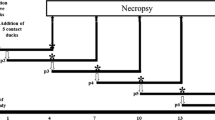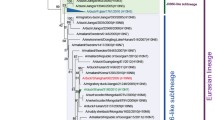Abstract
An H11N9 low-pathogenicity avian influenza virus, A/duck/WA/663/97, was isolated from a sick Mandarin duck kept in an outdoor bird exhibit. Genetic and phenotypic characterization of the virus suggested that it originated from free-flying birds, a concept supported by genetic similarity with waterfowl isolates from the same geographic area and time period. This duck-origin virus had genetic features typical of H11 and N9 viruses, including no neuraminidase stalk deletion, no differences in putative glycosylation sites in either surface protein, and no addition of basic amino acid residues at the hemagglutinin cleavage site compared to published sequences. It replicated in both avian and mammalian cells in vitro, and experimentally challenged chickens developed mild acute upper respiratory lesions but no clinical signs of disease. It elicited immune responses in chickens, resulting in seroconversion in all infected birds, although antibody titers remained low over the experimental period.






Similar content being viewed by others
References
Abolnik C, Bisschop SP, Gerdes GH, Olivier AJ, Horner RF (2007) Phylogenetic analysis of low-pathogenicity avian influenza H6N2 viruses from chicken outbreaks (2001–2005) suggest that they are reassortants of historic ostrich low-pathogenicity avian influenza H9N2 and H6N8 viruses. Avian Dis 51:279–284
Alexander DJ (2000) A review of avian influenza in different bird species. Vet Microbiol 74:3–13
Chen H, Li Y, Li Z, Shi J, Shinya K, Deng G, Qi Q, Tian G, Fan S, Zhao H, Sun Y, Kawaoka Y (2006) Properties and dissemination of H5N1 viruses isolated during an influenza outbreak in migratory waterfowl in western China. J Virol 80:5976–5983
Cowen BS, Braune MO (1988) The propagation of avian viruses in a continuous cell line (QT35) of Japanese quail origin. Avian Dis 32:282–297
Di Trani L, Bedini B, Cordioli P, Muscillo M, Vignolo E, Moreno A, Tollis M (2004) Molecular characterization of low pathogenicity H7N3 avian influenza viruses isolated in Italy. Avian Dis 48:376–383
Fouchier RA, Munster V, Wallensten A, Bestebroer TM, Herfst S, Smith D, Rimmelzwaan GF, Olsen B, Osterhaus AD (2005) Characterization of a novel influenza A virus hemagglutinin subtype (H16) obtained from black-headed gulls. J Virol 79:2814–2822
Gambaryan AS, Tuzikov AB, Piskarev VE, Yamnikova SS, Lvov DK, Robertson JS, Bovin NV, Matrosovich MN (1997) Specification of receptor-binding phenotypes of influenza virus isolates from different hosts using synthetic sialylglycopolymers: non-egg-adapted human H1 and H3 influenza A and influenza B viruses share a common high binding affinity for 6′-sialyl(N-acetyllactosamine). Virology 232:345–350
Gambaryan AS, Karasin AI, Tuzikov AB, Chinarev AA, Pazynina GV, Bovin NV, Matrosovich MN, Olsen CW, Klimov AI (2005) Receptor-binding properties of swine influenza viruses isolated and propagated in MDCK cells. Virus Res 114:15–22
Gill JS, Webby R, Gilchrist MJ, Gray GC (2006) Avian influenza among waterfowl hunters and wildlife professionals. Emerg Infect Dis 12:1284–1286
Hatta M, Gao P, Halfmann P, Kawaoka Y (2001) Molecular basis for high virulence of Hong Kong H5N1 influenza A viruses. Science 293:1840–1842
Hinshaw VS, Air GM, Gibbs AJ, Graves L, Prescott B, Karunakaran D (1982) Antigenic and genetic characterization of a novel hemagglutinin subtype of influenza A viruses from gulls. J Virol 42:865–872
Hoffmann E, Stech J, Guan Y, Webster RG, Perez DR (2001) Universal primer set for the full-length amplification of all influenza A viruses. Arch Virol 146:2275–2289
Jones YL, Swayne DE (2004) Comparative pathobiology of low and high pathogenicity H7N3 Chilean avian influenza viruses in chickens. Avian Dis 48:119–128
Kawaoka Y, Yamnikova S, Chambers TM, Lvov DK, Webster RG (1990) Molecular characterization of a new hemagglutinin, subtype H14, of influenza A virus. Virology 179:759–767
Levy AM, Gilad O, Xia L, Izumiya Y, Choi J, Tsalenko A, Yakhini Z, Witter R, Lee L, Cardona CJ, Kung HJ (2005) Marek’s disease virus Meq transforms chicken cells via the v-Jun transcriptional cascade: a converging transforming pathway for avian oncoviruses. Proc Natl Acad Sci USA 102:14831–14836
Liu J, Xiao H, Lei F, Zhu Q, Qin K, Zhang XW, Zhang XL, Zhao D, Wang G, Feng Y, Ma J, Liu W, Wang J, Gao GF (2005) Highly pathogenic H5N1 influenza virus infection in migratory birds. Science 309:1206
Macken C, Lu H, Goodman J, Boykin L (2001) The value of a database in surveillance and vaccine selection. In: A.D.M.E. Osterhaus NCAWH (ed) Options for the control of influenza IV.Elsevier, Amsterdam, pp 103–106
Matrosovich MN, Gambaryan AS, Teneberg S, Piskarev VE, Yamnikova SS, Lvov DK, Robertson JS, Karlsson KA (1997) Avian influenza A viruses differ from human viruses by recognition of sialyloligosaccharides and gangliosides and by a higher conservation of the HA receptor-binding site. Virology 233:224–234
McCracken C (2006) The influenza sequence database. Los Alamos National Laboratory
Mo IP, Brugh M, Fletcher OJ, Rowland GN, Swayne DE (1997) Comparative pathology of chickens experimentally inoculated with avian influenza viruses of low and high pathogenicity. Avian Dis 41:125–136
Myers KP, Setterquist SF, Capuano AW, Gray GC (2007) Infection due to 3 avian influenza subtypes in United States veterinarians. Clin Infect Dis 45:4–9
Nobusawa E, Aoyama T, Kato H, Suzuki Y, Tateno Y, Nakajima K (1991) Comparison of complete amino acid sequences and receptor-binding properties among 13 serotypes of hemagglutinins of influenza A viruses. Virology 182:475–485
Palmer D, Coleman M, Dowdle W, Schild G (1975) Advanced laboratory techniques for influenza diagnosis. US Department of Health, Education, and Warefare, Immunology Series No. 6
Peiris JS, de Jong MD, Guan Y (2007) Avian influenza virus (H5N1): a threat to human health. Clin Microbiol Rev 20:243–267
Rath NC, Parcells MS, Xie H, Santin E (2003) Characterization of a spontaneously transformed chicken mononuclear cell line. Vet Immunol Immunopathol 96:93–104
Reid AH, Janczewski TA, Lourens RM, Elliot AJ, Daniels RS, Berry CL, Oxford JS, Taubenberger JK (2003) 1918 influenza pandemic caused by highly conserved viruses with two receptor-binding variants. Emerg Infect Dis 9:1249–1253
Rohm C, Zhou N, Suss J, Mackenzie J, Webster RG (1996) Characterization of a novel influenza hemagglutinin, H15: criteria for determination of influenza A subtypes. Virology 217:508–516
Subbarao K, Klimov A, Katz J, Regnery H, Lim W, Hall H, Perdue M, Swayne D, Bender C, Huang J, Hemphill M, Rowe T, Shaw M, Xu X, Fukuda K, Cox N (1998) Characterization of an avian influenza A (H5N1) virus isolated from a child with a fatal respiratory illness. Science 279:393–396
Swayne DE, Perdue ML, Garcia M, Rivera-Cruz E, Brugh M (1997) Pathogenicity and diagnosis of H5N2 Mexican avian influenza viruses in chickens. Avian Dis 41:335–346
Swayne DE (2007) Understanding the complex pathobiology of high pathogenicity avian influenza viruses in birds. Avian Dis 51:242–249
Tumpey TM, Kapczynski DR, Swayne DE (2004) Comparative susceptibility of chickens and turkeys to avian influenza A H7N2 virus infection and protective efficacy of a commercial avian influenza H7N2 virus vaccine. Avian Dis 48:167–176
Acknowledgments
This project is supported by funds from the Center for Food Animal Health at the University of California, Davis. Drs Li, Xing, Woolcock and Cardona would like to express their heartfelt appreciation to Nichole L. Anchell, Nguyet Dao, and Phuong Dao for their expert technical support.
Author information
Authors and Affiliations
Corresponding author
Rights and permissions
About this article
Cite this article
Li, J., Cardona, C.J., Xing, Z. et al. Genetic and phenotypic characterization of a low-pathogenicity avian influenza H11N9 virus. Arch Virol 153, 1899–1908 (2008). https://doi.org/10.1007/s00705-008-0217-4
Received:
Accepted:
Published:
Issue Date:
DOI: https://doi.org/10.1007/s00705-008-0217-4




